Processing peaches in the spring for diseases and pests: when and how to spray
Peach can not be found as often in country gardens as the same apple or pear, since this fruit crop is very capricious in its care and requires increased attention. In order for the tree to bear fruit regularly, it must be properly looked after, including the spring processing of the peach in the spring against all kinds of diseases (especially against curly leaves) and pests.
Well, then we will try to clearly show and tell you when and how to spray peach trees in spring (before flowering) and in summer (after flowering).
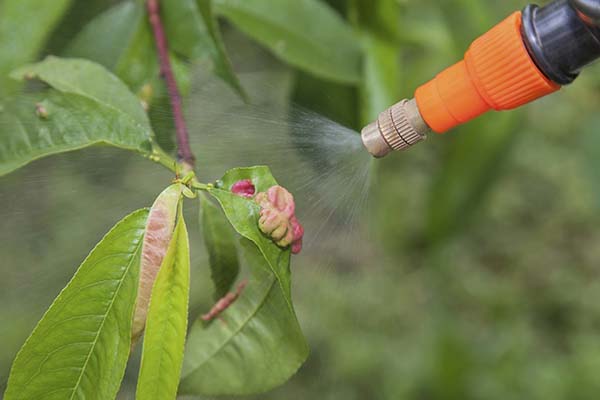
Content
Why spring peach processing is needed: main diseases and pests
So that in the spring the peach can recover faster after winter and enter the growing season in a timely manner, you need to provide it with maximum care and attention from the first days.
The beginning of spring is a period of awakening not only of plants, but also of the worst enemies of culture: wintering larvae of pests and fungal spores. But before taking proper care and processing the peach in the spring, you need to get to know the enemy (all diseases and pests of culture) "by sight".
Well, then we will consider what kind of fungal diseases and insect pests we will fight and protect the peach against during the spring garden treatments.
Diseases
Spring peach treatment is carried out against the following fungal diseases:
- Peach leaf curl - the most dangerous disease of this culture.
By the way! About, what is peach leaf curl (symptoms, causes), as well as how to deal with this fungal disease, told in this detailed material.
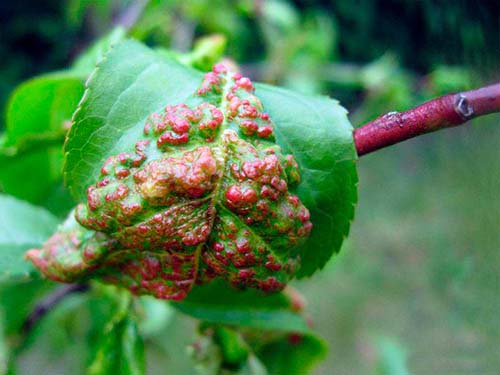
- Clasterosporium disease (perforated spot).
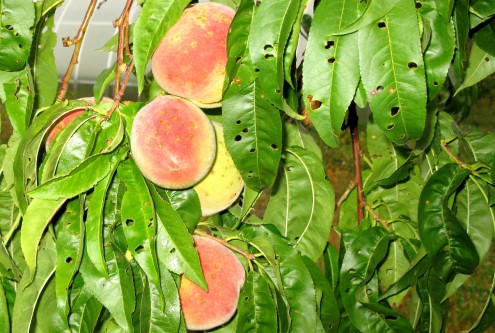
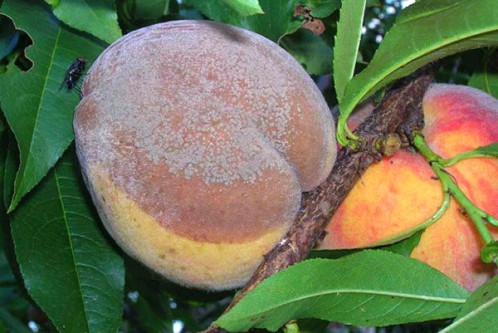
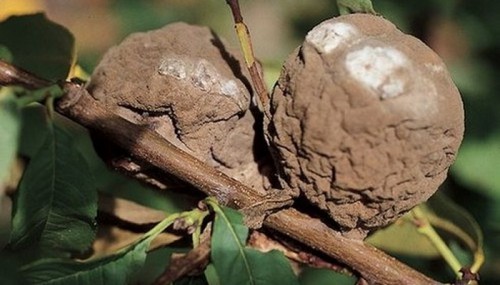
- Powdery mildew Is one of the most common problems (along with moniliosis) of all stone fruit cultures. It affects foliage, shoots and fruits, manifesting itself as an off-white (yellow) bloom.
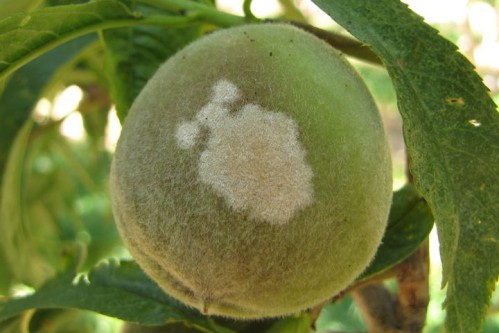

Rarely enough, peach trees pick up scab.
Pests
The most first treatment of peaches from pests is carried out against the following wintering stages of insect pests:
- scabbards;
- worm;
- aphids;
- ticks;
- suckers and other sucking and leaf-eating pests.
Second and subsequent peach treatments are already carried out against such pests as:
- Flower beetles - infect buds, buds and flowers. In addition, they are carriers of many fungal diseases.
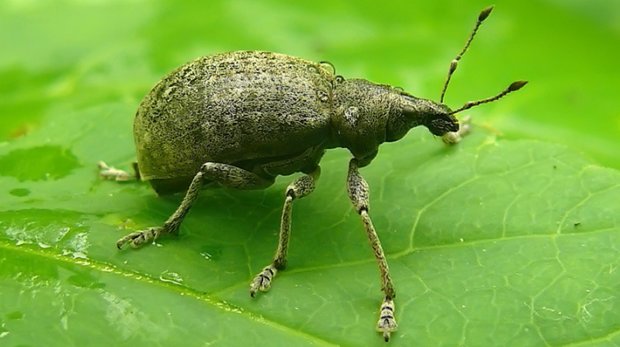
- Aphid - affects young foliage and shoots, feeding on their juice. It multiplies rapidly and forms numerous colonies. In the absence of protective procedures, it can cause serious harm to the culture and significantly slow down its development.
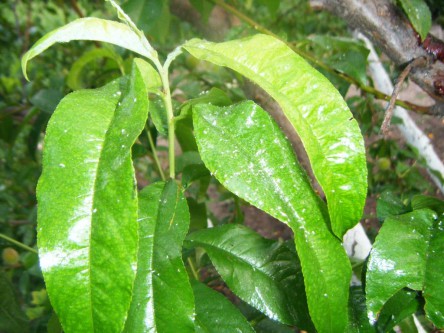
As a rule, peaches can be found blood aphid.
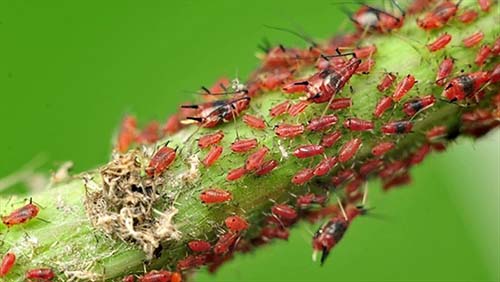
- Mite. It requires special treatment with acaricides. With a large number, it can greatly weaken the plant's immunity.
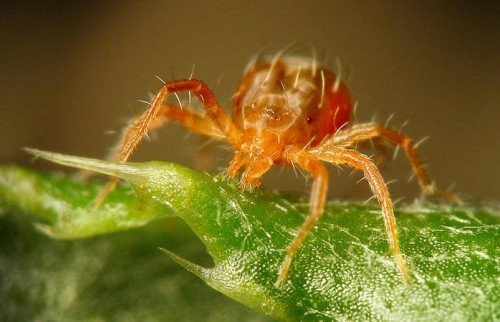
- Miner moth.
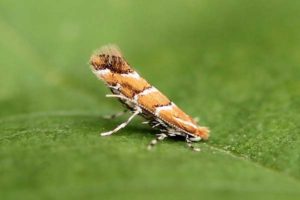
- Eastern and apple moth.
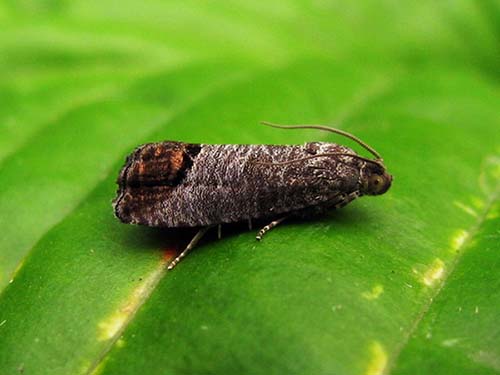
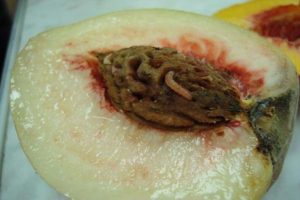
The main stages and terms of processing peach from diseases and pests: when to spray
It is very important not to be late and to carry out the first early spring peach processing on time.However, do not rush too much. If there is still snow outside the window or the weather is unstable: there is often precipitation - rains, sleet, fog, then spraying at this time will be simply ineffective.
Thus, when the weather is stable (+ 4..5 degrees during the day and not lower than 0 at night) and dry, the first treatment can be performed.
Note! If you did not have time to do it back in the fall (and you should have), then late winter - early spring (February-early March) highly desirable to implementwhitewash of trunks and low skeletal peach branches... This treatment will protect your fruit trees from sunlight (ultraviolet) rays and sudden temperature changes in the winter-spring period, which will prevent the appearance of cracks on them, into which various infections (fungal spores) and pests can no longer get.
By the way! About, how and how to whiten fruit trees (including peaches) in autumn and spring,read in this article.
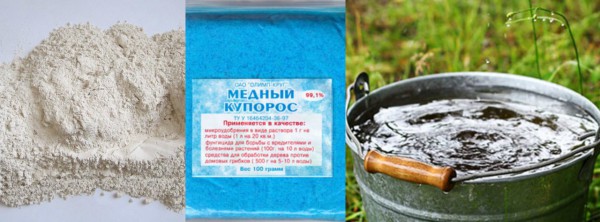
It is quite obvious that different diseases and pests appear at different times. Accordingly, for each phase of the development of a peach, there should be its own specificity of its processing.At the same time, it is very difficult to name specific dates, it is much easier and more correct to focus on the phases of development (vegetation) of the peach tree in spring.
So, there is a certain scheme for treating the garden in spring, according to which spraying is carried out in the following stages of development (vegetation) of the peach:
It is necessary to process a peach in the spring from diseases and pests at least 4 times, which guarantees the protection of the crop and obtaining an excellent harvest.
- Before awakening or budding, while they are still asleep.
This processing is also called "Early spring spraying", and more often by spraying "on a bare tree", because at this time, no signs of awakening (vegetation) have yet appeared on the peach.
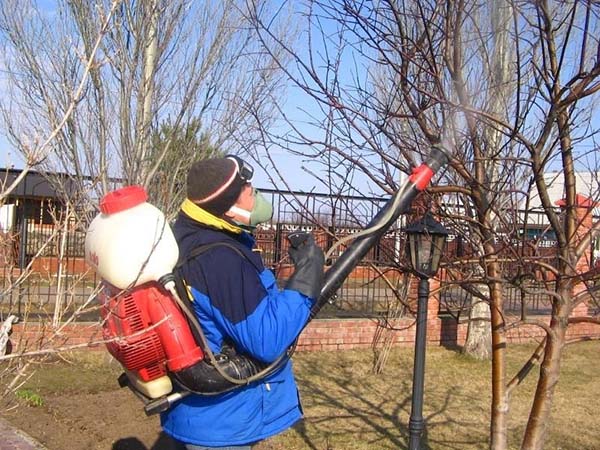
By the way! Instead of processing on dormant buds, some gardeners spray on those that have already begun to swell (wake up)
- "Along the green cone." When the buds have already swollen and burst, but the leaves have not yet appeared (unfolded).
- "By rosebuds". Also called the stage of "bud extension or separation."
Interesting! Sometimes the treatment is carried out directly during flowering, but exclusively against diseases.
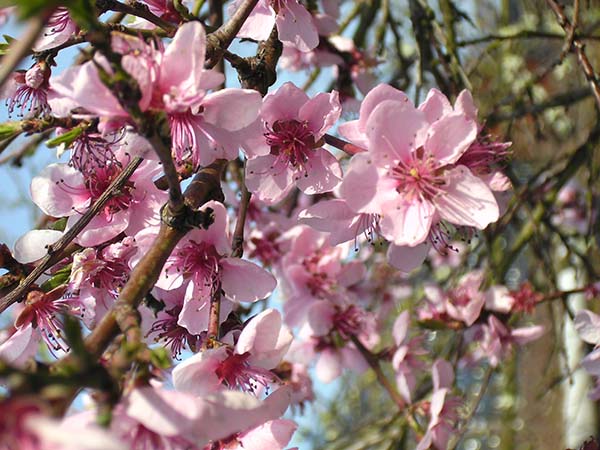
- "On the ovary with a pea." In other words, after flowering, when small ovaries are already formed.
- In the future (already in the summer), at the stage of growth and formation of fruits, it is also imperative to carry out preventive and therapeutic treatments (if you do not want to use chemicals, then at least spray with biological preparations).
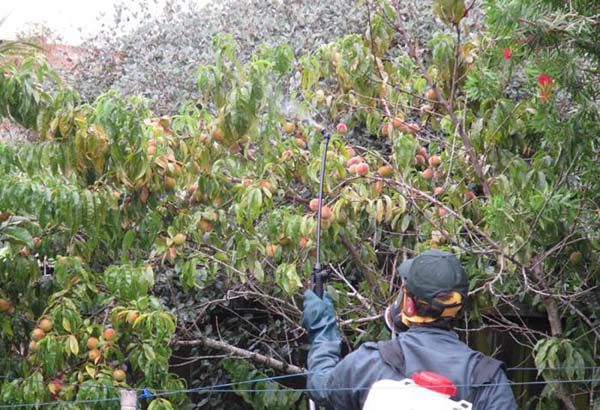
- In the fall (after leaf fall), it is necessary to carry out an autumn eradication spraying (with copper or iron vitriol, Bordeaux liquid).
Video: spraying scheme for peaches and other fruit trees in spring
Important! If it seems to you that it is unrealistic to carry out such a number of treatments, then this is not at all the case, even if you are in the country only on weekends (1-2 days a week). Each stage does not last one day, but about a week or more. In addition, you can track all stages on city trees.
Before bud awakening or early spring spraying "on bare trees"
For the first time, it is necessary to process a peach in the spring against diseases and pests. before bud breakwhen they are still dormant.
By the way! The site already has a separate material on how to conduct spring eradication garden spraying in early spring.
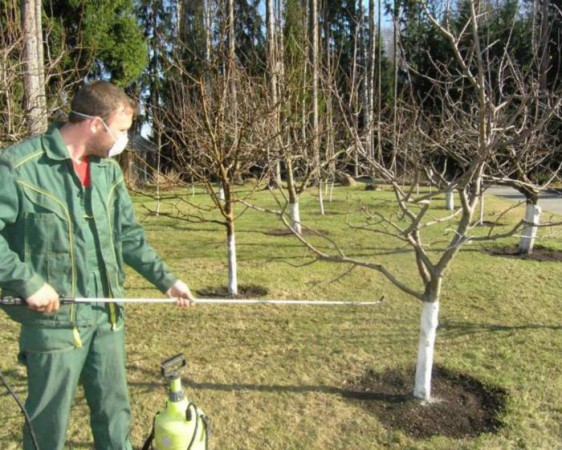
Spraying in the "green cone" stage
The second processing of peaches in the spring for diseases and pests should be carried out during the period of swelling and budding, in other words, in the "green cone" stage.
This phase is characterized by the fact that the buds on the trees have already burst, but the leaves have not yet unfolded, although they are already clearly visible (hence the "green cone").
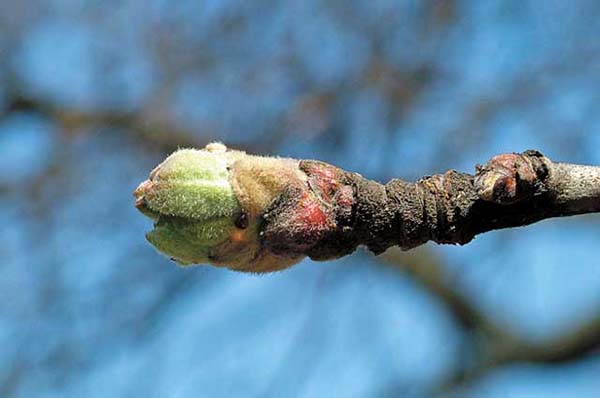
Note! Spraying in the "green cone" phase is considered the most important and most favorable period for the treatment of peaches from diseases and pests.
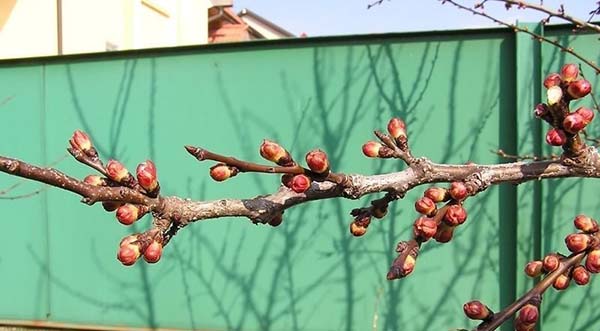
Important!If for some reason you did not carry out the processing at the previous stage, then it is better hurry up, because the the duration of this phase ("green cone") is relatively short... Moreover, if the weather is good, sunny, the temperature is stably above +10 degrees, then the kidneys will open quite quickly.
At this stage, as a rule, are already using more serious means:
- against klyasterosporiosis - Horus or Skor (or its full analogue Raek);
Important! Chorus must be used at temperatures up to +15 degrees, Speed (Raek) - above +15.
- curl leaves - Horus or Speed.
Also against clotterosporia and curliness contact fungicidal preparations can be used copper based, for example, Abiga-peak, Hom, Oksikhom.
Specificity! For example, Horus works great at low positive temperatures (about +4 .. + 5, but up to +15), a Speed or Rayokon the contrary, it works better at higher temperatures (from +10 .. + 15)... Therefore, at the stages before the buds emerge and flowering (in the “green cone” phase), it is advisable to spray with Horus, and Skor - already at the “pink bud” stage and after flowering (“pea-sized ovaries”).
As for treatments against pests, it's time to start fighting with flower beetles (weevils), for example, Aktara.
However, if you skipped the previous processingthen in the "green cone" stage it is still possible to spray the peach bordeaux liquid or one of the solutions based on copper or ferrous sulfate from urea... And also apply against wintering stages of pests special preparation - "Prophylactin" and "Preparation 30 Plus".
By the way! Copper sulfate and Bordeaux liquid, which also contains copper, perfectly protect against curly leaves.
At the same stage for additional protection of peaches from insect pests You can put on boles trees special trapping belts, build and hang on branches glue traps, pheromone houses.
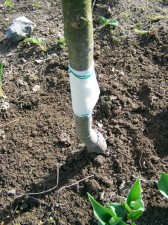
Video: the second spring spraying of the garden
Spraying in the bud extension stage or in the "rose bud" phase
The third stage of processing peaches in the spring from diseases and pests is carried out at a stage when the bud has already formed and advanced (it is pink), but has not yet opened.
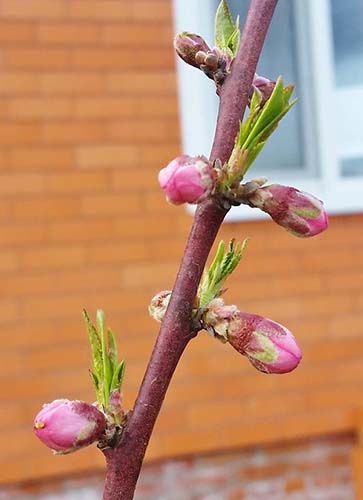
At this stage, spraying must be carried out against the following diseases:
- against klyasternosporiosis - Horus, Skor;
- curl leaves - Horus, Skor, Delan;
- monilial burn - Horus;
- powdery mildew - Topaz.
Also against clotterosporia and curliness fungicidal preparations can be used copper based, for example, Abiga-peak, Hom, Oksikhom.
With regard to treatments against pests, then
- vs flower beetle - Aktara, Karate Zeon;
- aphids, suckers - Aktara;
- ticks - Karate Zeon;
- leaf rollers - Insegar, Voliam Flexi;
- miner moth - Insegar, Proclaim.
You can use any similar means aimed at the listed pests, the above is just an example.
Temperature conditions during the rosebud stage tend to improve, weather it is warm and sunny (temperature + 10-15 degrees and above), which means you can start using biological drugs (see separate paragraph "Biologicals").
Video: peach processing in the rosebud phase
Spraying after flowering "on the ovary with a pea"
Immediately after flowering, when small ovaries are already formed, it is necessary to produce complex processing of peaches as against diseases (especially against moniliosis)and against pests (especially from moths).
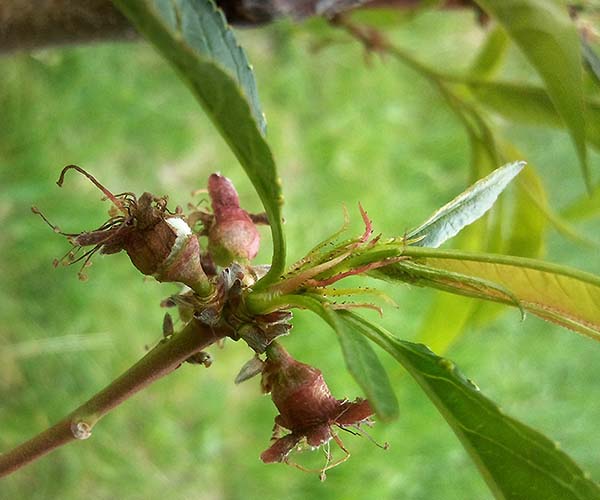
Spraying must be carried out with similar preparations:
- against klyasternosporiosis - Horus, Skor;
- curly leaves - Horus, Speed;
- moniliosis (monilial burn and fruit rot) - Horus;
- powdery mildew - Topaz.
Also against clotterosporia and curliness fungicidal preparations can be used based on copper oxychloride, for example, Abiga-peak, Hom, Oksikhom.
With regard to treatments against pests, then
- against aphids, honey plants - Aktara, Voliam Flexi;
- ticks - Karate Zeon, Vertimek;
- leaf rollers - Insegar, Voliam Flexi, Lufoks, Proclame;
- miner moth - Insegar, Proclaim.
- moths - Insegar, Lufox, Voliam Flexy, Proclaim, Match.
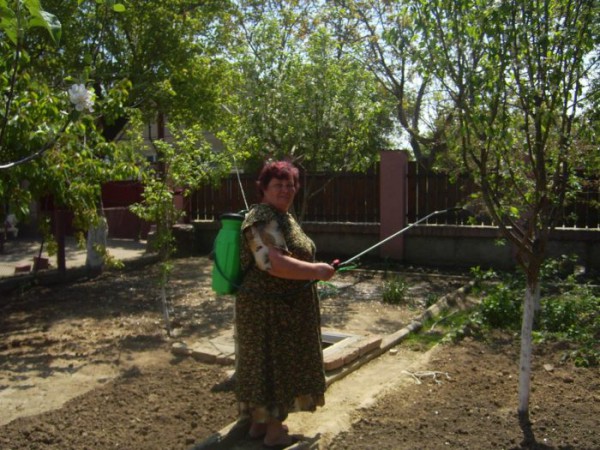
Advice! If some leaves do pick up curl, then they will need to be removed manually.
How to properly spray a peach in spring
Basic rules and recommendations for effective spring spraying of peaches against diseases and pests:
- While preparing solutions and spraying treesobserve safety precautions... If the packaging of the product says that you need to wear special clothing (gown, overalls, raincoat), goggles and a respirator, rubber gloves, then you need to wear it.
- Processing should only be carried out in dry and calm weather.
In sunny weather, it is better to refrain from spraying, since, quickly drying out, the drugs become ineffective or do not work at all. Spraying is best done in cloudy, calm weather, but not in the rain: after the rain, the branches are damp, like a thin "film" of water on them. And spraying is droplets of solution, which cover the plant with a thin "film" of drops in the same way. If processing is carried out, then the concentration of the solution will decrease, and the processing efficiency will decrease.
- Spraying is desirable to carry out in the morning (after dew has dried) or late at night (after sunset).
Too early treatment will be ineffective due to the dew that has not evaporated and the high humidity of the air.
- Processing is always carried out exactly after spring peach pruningto further protect the cut sites (ideally if you sprinkle them with copper sulfate or Bordeaux liquid, in other words, if there is copper in the fungicide).
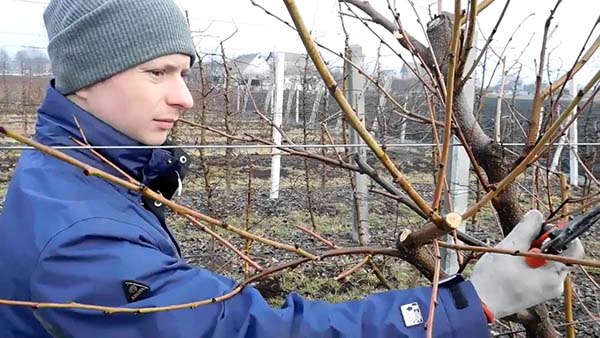
- Do not do it spray against pests during flowering (can harm bees and other pollinators), only from diseases.
- All prepared solutions should be pass through a filter meshso as not to clog the sprayer.
- Suitable for dissolving almost all drugs room temperature water (for vitriol, it is advisable to use hot water, about + 40-50 degrees).
What if you are using a biological productthen water better to take settled or filtered, i.e. chlorine free.
- At each stage, you can use like the same drugs (for the sake of economy) and new (better change the active ingredient so that there is no addiction - this will be more effective), or alternate (use alternately).
During each phase, you can carry out not 1, but 2 or more treatments, if it is indicated in the instructions for the preparation, especially after flowering.
- You can prepare tank mixtures that will have insecticidal and fungicidal properties (in this case, it is necessary to clarify the compatibility of drugs).
However! Some agronomists believe that do not immediately give a double chemical load on the plant... It is better to take a break for at least 1 day (for example, treat it with a fungicide on Saturday morning, and an insecticide on Sunday morning). You can also spray at intervals of 1 week, i.e. on one weekend they were treated for pests, on the next - for diseases (or vice versa).
The specifics of processing adult (old) and young trees
Naturally, adult fruiting peaches need to be fully processed in the spring, i.e. in 4 stages.
It's another matter, until the tree blooms and bears fruit, it is obvious that insects stick to it less. Therefore, it will be enough to process young peach trees only 3 times:
- on sleeping buds from diseases and hibernating pests;
- "Along the green cone" against insect pests;
- after flowering - from diseases (especially against monilial burn).
Note! Peach is one of the fastest growing fruit crops, whichstarts fruit already in the 3rd year after planting.
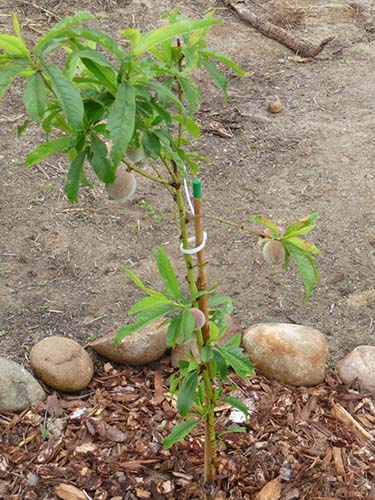
How to process peaches in the spring from pests and diseases: the best drugs
For the spring processing of the garden, there are a large number of funds, but what exactly to process the peach in the spring from diseases and pests, before proceeding with the procedure, you need to decide in advance. As well as how to use drugs, how much to use them. Let us examine this issue in more detail below.
Note! At each stage, you can use both the same drugs (in order to save money), and new ones (and it is better to change the active ingredient so that there is no addiction - it will be more effective), or alternate (use alternately).
Important! The instructions for each drug always indicate when (in what time frame) and how many times they need processing.
So, for effective spring processing of peaches, you will need:
- fungicides (drugs to fight diseases);
By the way! In this case, fungicides are divided into preparations protective (prophylactic) and curative action, and protective-healing.
Of course, it is optimal to use complex drugs that have protective and therapeutic effects.
Accordingly, if you noticed signs of illness, then no preventive (protective) means will help you, only healing (or protective-healing).
- insecticides (insect pest control agents);
- insectofungicides (complex preparations acting simultaneously against pests and diseases).
By origin, these agents (fungicides and insecticides) can be:
- chemical (those same "chemicals");
- biological (biological products).
Of course, there are also folk remedies, for example, various solutions and infusions based on herbs, etc. But their effectiveness is very, very limited.
Chemicals and biologicals
Note! Many gardeners have a preconceived notion that the use of chemicals negatively affects (carries negative consequences) on the quality of the future harvest and human health. However, this does not correspond to reality, since after the expiration of the waiting period, all harmful substances (pesticides) are removed long before ripening and harvesting.
In contrast to biological products, chemical agents act much faster and more reliably. In addition, the use of chemicals is very often the only way to cure a crop of fungal diseases and get rid of annoying pests.
TOOf course, in this case, it is imperative to fully comply with the recommendations for their dosage and the timing of the spraying.
Whereas biological drugs and folk remedies have a more gentle effect, which is permissible only in the following cases:
- with a small number of pests;
- at the initial stage of development of a fungal disease or mild infection, and even better as a prophylaxis (protection), but in no way an active fight.
Fungicides (chemical)
As for the preparations suitable for spring spraying of peaches against diseases, the following can be used fungicides (chemical agents for combating fungal plant diseases):
Important! For one treatment, you need to choose only one drug (fungicide), and then use a new one (preferably with another active ingredient), or alternate.
- Bordeaux mixture (contact fungicide, 3% solution of Bordeaux liquid - before bud break and 1% - in the "pink bud" stage - from clasterosporium, curl and moniliosis);
By the way! The site already has a detailed article on the preparation and use of Bordeaux liquid.
- Copper sulfate (contact fungicide, from clasterosporium, curl and moniliosis);
Advice! More details on the fields of application of copper sulfate readin this material.
- Inkstone;
About, when, how and why to use iron vitriol, detailed in this article.
- Carbamide (urea);
Usually, urea is used together with copper or iron sulfate, namely, the tank mixture is being prepared.
- Abiga peak (protective contact fungicide based copper oxychloride, against clasterosporium disease, moniliosis and curliness);
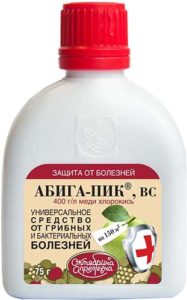
- Hom (contact fungicide protective actions based on copper oxychlorideagainst clotterosporia, moniliosis and curl);
- Oxyhom (contact systemic fungicide protective actions based on copper oxychloride and oxadixyl, against clotterosporia, moniliosis and curl);
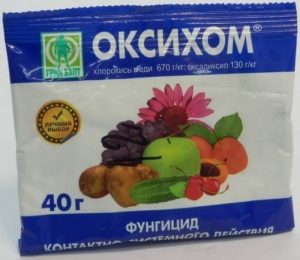
- Tiovit Jet (contact fungicide based sulfur, especially effective against powdery mildew and mites);
- Delan (contact fungicide, protective and curative actions based on dithianon, against curly leaves, clotterosporia, scab);
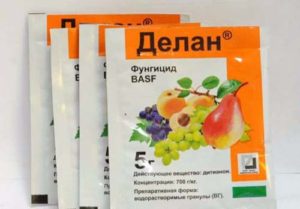
- Forecast (systemic fungicide protective and healing actions based onpropiconazole, against curly leaves, powdery mildew);
- Tilt (systemic fungicide protective and healing actions based onpropiconazole, against curly leaves, powdery mildew);
- Topsin-M (systemic contact protective fungicide actions based onThiophanate methyl, against scab, powdery mildew, curly leaves, moniliosis of fruit rot and monilial burn, clasterosporium);
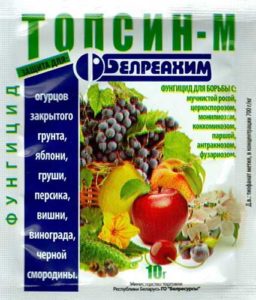
- Horus (systemic fungicide of protective and curative action based cyprodinil, against moniliosis - fruit rot and monilial burn, clasterosporium disease, curly leaves);
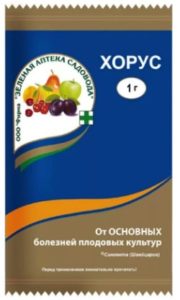
- Speed (systemic fungicide of protective and curative action based difenoconazole, against clotterosporia and curly leaves, as well as scab);
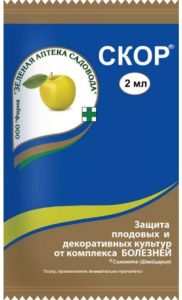
- Raek (systemic fungicide of protective and curative action based difenoconazole,against klyasternosporia and curly leaves, as well as scab);
In fact, Skor = Raek (its analogue).
- Strobe (systemic fungicide protective and healing actions based on kresoxim-methyl, against scab, powdery mildew, leaf spot - klyasternosporiosis, curly leaves);
- Ridomil Gold (systemic contact fungicide, protective and curative actions based on mancoceb and mefenoxam, against curly leaves);
- Topaz (protective systemic fungicide basedpenconazole, against powdery mildew);
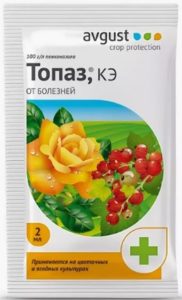
- Bayleton (systemic fungicide basedtriadimephone, against scab, powdery mildew, curly leaves, rust, oidium, gray rot);
- And other contact and systemic fungicides of a wide spectrum of action.
Advice! Carefully study the instructions: the scope of the drug (against what diseases), timing, dosage!
Insecticides (chemical)
As for preparations suitable for spraying peaches in spring against pests, the following insecticides (pest control agents) can be used:
Important!For one treatment, you need to choose only one drug (insecticide), and then use a new one (preferably with another active ingredient) or alternate.
The active ingredients are indicated in brackets.
- Aktara (Thiamethoxam (Aktara), systemic insecticide of intestinal action, against flower beetle, honeydew, aphids);
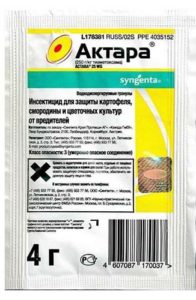
- Actellic (Pirimiphos-methyl (Actellic), systemic insecticide of contact-intestinal action against ticks);
- Prophylactin (Vaseline oil and Malathion (Karbofos), enteric insecticide against wintering stages of pests - ticks, aphids, scale insects, leafworms, honeycorns, etc.; ideal for swelling buds in early spring).
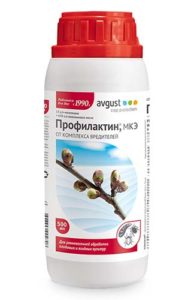
- Preparation 30 plus (contact insect-acaricide from the wintering stages of pests - scale insects, false scale insects, ticks, aphids, coppers, moths, worms; spray during dormancy).
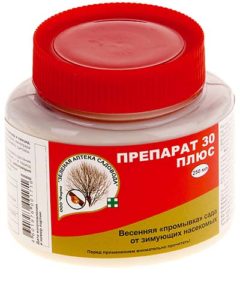
- Fufanon-Nova (Malathion (Karbofos), enteric-contact insectoacaricide from moth, honey moth, leafworm, aphids, ticks);
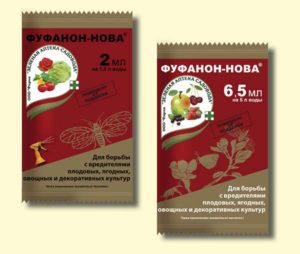
- Aliot (Malathion (Karbofos), enteric-contact insectoacaricide from moth, honey moth, leafworm, aphids, ticks);
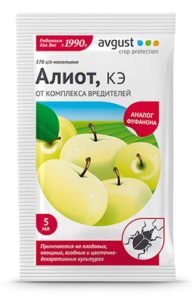
Fufanon and Aliot are complete analogues!
- Decis Profi (Deltamethrin,enteric insecticide, against flower beetle, moth, leafworm and aphids);
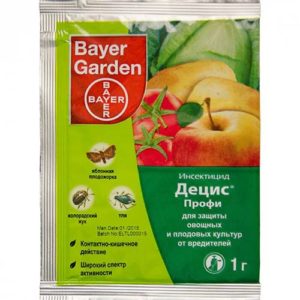
- Hyphen Expert (Deltamethrin, enteric insecticide, against flower beetle, moth, leafworm and aphids);
- Karate Zeon (Lambda Cyhalothrin,enteric insecticide, against the flower beetle, moth, leafworm, ticks, aphids);
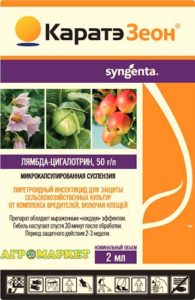
- Kinmix (Beta-cypermethrin, enteric insecticide from moth, leafworm, flower beetle, aphid, honeydew);
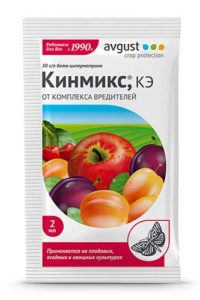
- Biotlin (Imidacloprid, a systemic insecticide of contact-intestinal action, against aphids; spray before flowering);
- Engio (Thiamethoxam ilambda-cyhalothrin, against moth, aphids, ticks);
- Caesar (Alpha cypermethrin, insecticide of contact-intestinal action, against moth, aphids);
- Movento Energy (Imidacloprid pyrotetramate, a systemic insecticide of contact-intestinal action, against the moth, leafworm, scabbard, honeydew, aphids);
- Belt (Flubendiamide, systemic insecticide of contact-intestinal action, against moth, leafworm, miner moth);
- Calypso (Tiacloprid, systemic insecticide of contact-intestinal action, against moth, leafworm, scale insect, flower beetle);
- Brand (Emamectin benzoate,insecticide of intestinal action from the moth and grape moth);
- Vertimek (Abamectin, enteric insecticide against ticks, copperheads);
- Lufox (Lufenuron and Fenoxycarb, insecticide of intestinal action from the moth and grape moth);
- Match (Lufenuron, insecticide of intestinal action from the moth)
- Insegar (Fenoxycarb, insecticide of intestinal action from the moth and grape moth);
- Voliam Flexy (Thiaetoxam (Aktara) and chlorantraniliprol, a systemic insecticide of intestinal action against the moth, miner moth, grape moth, aphids, thrips and leafhoppers);
- And other broad-spectrum insecticides.
Advice! Carefully study the instructions: the scope of the drug (against which pests), timing, dosage.
Video: how to spray trees in spring from insect pests
Biological products of fungicidal and insecticidal action
Biological products are created on the basis of living organisms:
- mushroom antagonists;
- bacteria;
- bacterial viruses;
- beneficial insects (entomophages and acariphages).
Among biological products, fungicides, insecticides, and insectofungicides can be distinguished.
Note! As a rule, almost all biological products work effectively under the condition of a sufficiently high positive air temperature (+ 10 ... + 15 degrees), so they begin to be used only at the “rosebud” stage, while the first and second treatments must be carried out using chemical agents.
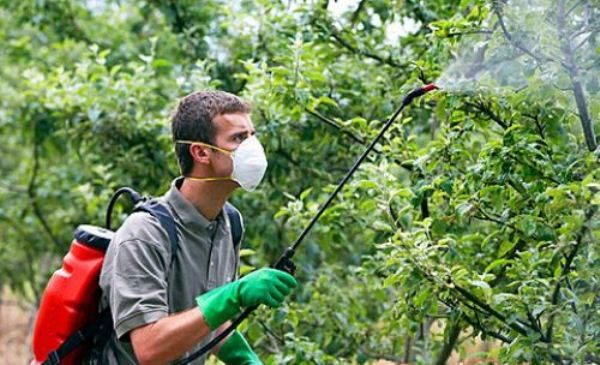
Biologicals fungicidal action (against diseases):
- Fitolavin (fungicide, from moniliosis = fruit rot);
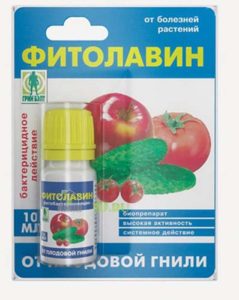
- Alirin-B (systemic contact fungicide of protective and curative action, against powdery mildew, moniliosis);
- Fitosporin (contact fungicide, from powdery mildew, moniliosis, curly leaves);
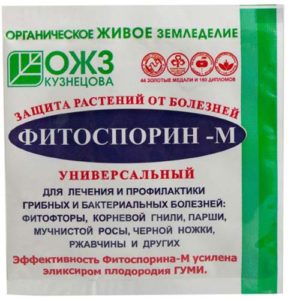
- Planriz (contact fungicide, from moniliosis, leaf spots, including curl);
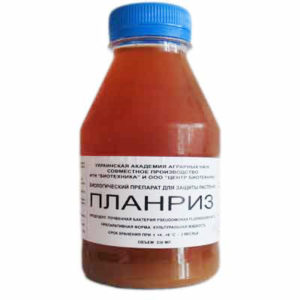
- Trichodermin or Trichoderma (fungicide, from moniliosis, leaf spots, including curl);
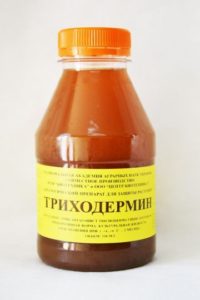
- Pentafag-C (fungicide, from powdery mildew, leaf spots, including curl).
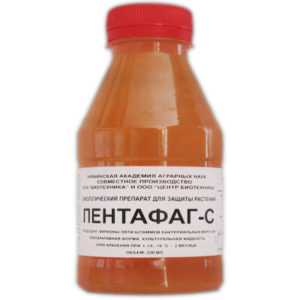
Biologicals insecticidal action (against pests):
- Fitoverm (Aversectin C,from moths, leaf rollers, ticks, aphids);
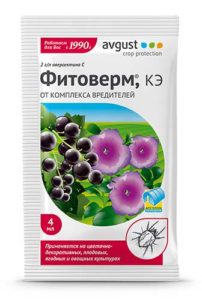
Fitoverm, Kleschevit and Aktofit are analogues.
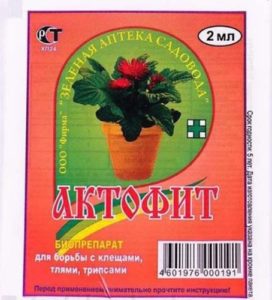
- Bitoxibacillin (from moth, leafworm, moth);
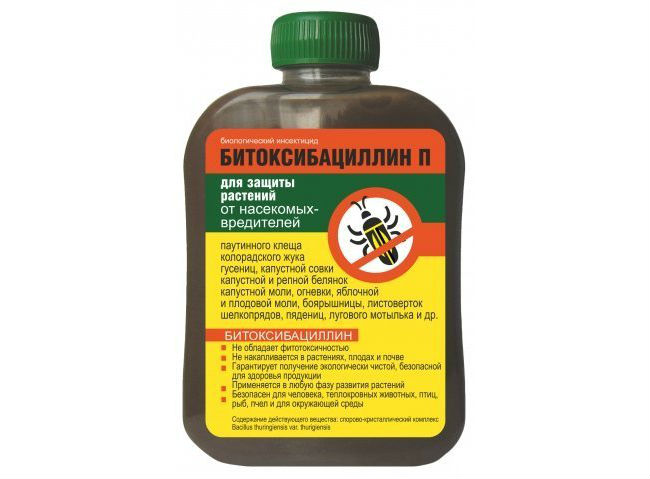
- Lepidocide (from moth, moth);
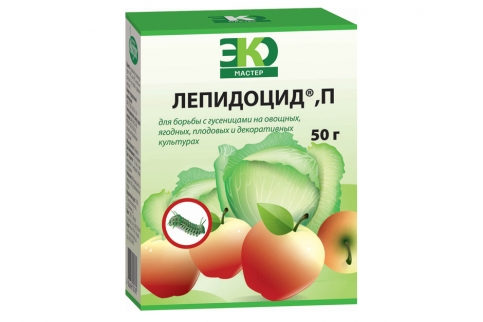
- Gaupsin (complex action insectofungicide, from moniliosis, leaf spots, including curliness, scab, powdery mildew, moth, aphids, leafworms and other pests).
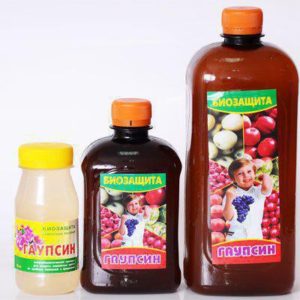
Note! Yes, biologicals have their advantages (they are environmentally friendly, have a short waiting time), but it should be admitted that they are not as effective as chemical ones.
Tank mixtures (fungicides + insecticides)
Note! Not all drugs can be mixed.For example, practically nothing can be mixed with Bordeaux liquid (it has an alkaline reaction).
The instructions should say which drugs they can be combined with.
For spring spraying of peach (except for the first one, when the buds are still sleeping), you can prepare the following tank mixtures (fungicide + insecticide):
Chemical:
- Horus (fungicide) + Decis Profi (insecticide);
At higher temperatures (+10 .. + 15 degrees)Chorus is better to replace with Speed (fungicide) + Decis Profi.
- In principle, you can replace Hyphen Profi with Aktara (insecticide): Aktara + Horus and Aktara + Speed.
Engio - also works great when paired with Horus or Skor.
- Speed + Topaz;
- Horus (or Skor) + Aktara + Karate Zeon;
- Bayleton (fungicide) + Karate (insecticide);
- Tilt (fungicide) + Caesar (insecticide);
- Skor (or Horus) + Caesar (insecticide).
By the way! The Speed + Horus tank mix is believed to protect the peach by 99% from all major diseases.
Biological:
- Lepidocide + Bitoxibacillin + Gaupsin (insectofungicide)
Against curly leaves and other diseases:
- Planriz (fungicide) + Trichodermin (fungicide) + Pentafag-C (fungicide);
- Planriz (fungicide) + Trichodermin (fungicide) + Gaupsin (insectofungicide).
- Planriz (fungicide) + Pentafag-C (fungicide) + Gaupsin (insectofungicide).
Folk remedies against pests
Folk remedies can be used as preventive measures to protect peaches from pests. They are completely safe and environmentally friendly both for the garden and for humans.
- Infusion of tobacco. To prepare the infusion, you need: 0.5 kg of dried tobacco, pour 10 liters of water and insist for 2 days. Then boil for an hour, let stand again for 1 day. Then add 1 liter of infusion, 40 grams of soap to 10 liters of water and spray.
By the way! Alternatively, you can use tobacco dust.
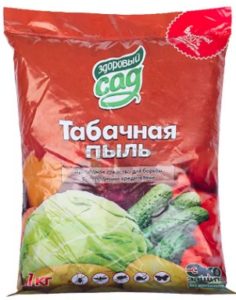
- Infusion of onion peel (from spider mites and aphids).
- Infusion of chamomile officinalis. The mixture helps scare off many pests... To prepare the working solution, you need to pour 0.5 kg of dry collection of the plant with 5 liters of boiling water, leave to infuse for at least 12 hours. Grate 40 g of laundry soap into the resulting mixture and add water to 10 liters. Strain and apply to spray the trunk and crown.
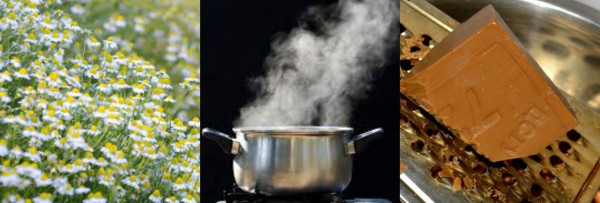
- Hot pepper decoction. It is recommended to use against pests... Pour dried pepper pods (100 g) with boiling water (1 l) and cook for 2 hours. Insist for two hours, then clean and add water to a total volume of 10 liters. Use for spraying shoots and leaves.
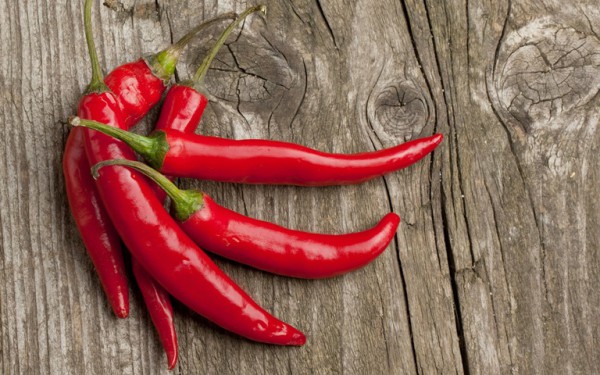
And let your peaches be like that!
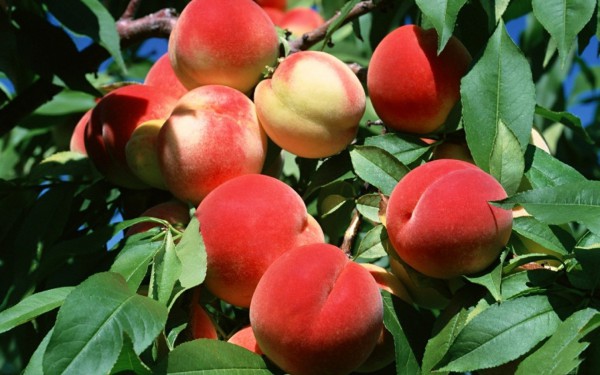
Full-fledged peach care in spring cannot be imagined without pest and disease control, since the harvest can only be obtained if the tree is processed in a timely and high-quality manner. And what exactly to spray your peach trees is your personal choice, just do not ignore the dosage and timing of spraying. And remember, peach processing in spring is the most important crop protection measure that will allow you to reap a rich harvest of tasty and healthy fruits.


Please tell me how to process the currants, the leaves curl up, the berries wither.
Good day! If your black? the currant was attacked by aphids (it is the tops of the shoots that curl, right?), then it will be useful for you this pest control material.
But the berries are usually damaged gooseberry moth.